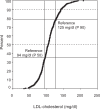Frequency of secondary dyslipidemia in obese children
- PMID: 19183757
- PMCID: PMC2605332
- DOI: 10.2147/vhrm.s2928
Frequency of secondary dyslipidemia in obese children
Abstract
Objective: This paper reports the frequency, type, and degree of dyslipidemia in obese children before therapeutic intervention. The relationships between lipid values and weight status, as well as lipid values and physical fitness, of these children were also investigated.
Design and methods: The initial examination of the Freiburg Intervention Trial for Obese Children (FITOC) measured the values of triglycerides (TG), total cholesterol (C), low-density lipoprotein cholesterol (LDL-C), and high-density lipoprotein cholesterol (HDL-C) in 546 obese children aged 7-12 (body mass index [BMI] > 97th percentile), and compared these values with those of the age- and sex-specific reference group in the Lipid Research Clinics Population Studies Data Book (LRC). Four groups were selected according to the following scheme: A, Normolipidemia; B, Hyper-LDL-cholesterolemia alone; C, Hypo-HDL-C + hypertriglyceridemia; D, Combined hyperlipidemia = Hyper-LDL-C + hypertriglyceridemia. Body mass index, BMI-SDS (corrected BMI), and physical performance in watt/kg body weight were measured.
Results: A total of 45.8% of the overweight children showed an abnormal lipid profile. Ten percent of the children had high LDL-C levels (group B), while 15% had increased LDL-C and increased TG (group D) (higher prevalence in boys). In 18.9% we found increased TG, combined with decreased HDL-C values (group C).
Conclusion: Obese children are at risk of dyslipoproteinemia and related diseases. Children with the highest BMI-SDS and lowest physical fitness have the lowest HDL-C values and increased TG, indicating a higher risk for the metabolic syndrome.
Keywords: atherosclerotic risk; childhood; dyslipidemia; obesity.
Figures
Similar articles
-
Glycolipid metabolic status of overweight/obese adolescents aged 9- to 15-year-old and the BMI-SDS/BMI cut-off value of predicting dyslipidemiain boys, Shanghai, China: a cross-sectional study.Lipids Health Dis. 2013 Aug 28;12:129. doi: 10.1186/1476-511X-12-129. Lipids Health Dis. 2013. PMID: 23984682 Free PMC article.
-
[Study on the relationship between obesity and lipid metabolism in children and adolescent in yinchuan].Wei Sheng Yan Jiu. 2014 Sep;43(5):779-83. Wei Sheng Yan Jiu. 2014. PMID: 25438534 Chinese.
-
Combined dyslipidemia in obese children: response to a focused lifestyle approach.J Clin Lipidol. 2014 Mar-Apr;8(2):181-6. doi: 10.1016/j.jacl.2014.01.003. Epub 2014 Jan 19. J Clin Lipidol. 2014. PMID: 24636177
-
Pitavastatin: novel effects on lipid parameters.Atheroscler Suppl. 2011 Nov;12(3):277-84. doi: 10.1016/S1567-5688(11)70887-X. Atheroscler Suppl. 2011. PMID: 22152282 Review.
-
Dyslipidemia in the metabolic syndrome in children.J Cardiometab Syndr. 2006 Summer;1(4):282-5. doi: 10.1111/j.1559-4564.2006.05798.x. J Cardiometab Syndr. 2006. PMID: 17679808 Review.
Cited by
-
Comparison of different criteria for the definition of insulin resistance and its relationship to metabolic risk in children and adolescents.Ann Pediatr Endocrinol Metab. 2020 Dec;25(4):227-233. doi: 10.6065/apem.2040002.001. Epub 2020 Jul 30. Ann Pediatr Endocrinol Metab. 2020. PMID: 32871651 Free PMC article.
-
Anthropometric features as predictors of atherogenic dyslipidemia and cardiovascular risk in a large population of school-aged children.PLoS One. 2018 Jun 1;13(6):e0197922. doi: 10.1371/journal.pone.0197922. eCollection 2018. PLoS One. 2018. PMID: 29856786 Free PMC article.
-
Nutritional Approach to Prevention and Treatment of Cardiovascular Disease in Childhood.Nutrients. 2021 Jul 10;13(7):2359. doi: 10.3390/nu13072359. Nutrients. 2021. PMID: 34371871 Free PMC article. Review.
-
Diagnosis, treatment and prevention of pediatric obesity: consensus position statement of the Italian Society for Pediatric Endocrinology and Diabetology and the Italian Society of Pediatrics.Ital J Pediatr. 2018 Jul 31;44(1):88. doi: 10.1186/s13052-018-0525-6. Ital J Pediatr. 2018. PMID: 30064525 Free PMC article. Review.
-
Glucose and Lipid Profiles of Overweight and Obese Children in Riyadh, Saudi Arabia.Cureus. 2023 May 11;15(5):e38902. doi: 10.7759/cureus.38902. eCollection 2023 May. Cureus. 2023. PMID: 37313072 Free PMC article.
References
-
- [AAP] American Academy of Pediatrics, Committee on Nutrition. Cholesterol in childhood Cholesterol in childhood. Pediatrics. 1998;101:141–7. - PubMed
-
- Berenson GS, Srinivasan SR, Bao W, et al. Association between multiple cardiovascular risk factors and atherosclerosis in children and young adults. The Bogalusa Heart Study. N Engl J Med. 1998;338:1650–6. - PubMed
-
- Berg A, Halle M, Bauer S, et al. Physical activity and eating behavior: strategies for improving the serum lipid profile of children and adolescents. Wien Med Wochenschr. 1994;144:138–44. - PubMed
-
- Berg A, Korsten-Reck U. [Strategien zur Verbesserung des Aktivitäts- und Ernährungsverhaltens bei Kindern und Jugendlichen] Der Lipidreport. 1995;4:15–22.
-
- Cole TJ, Green PJ. Smoothing reference centile curves: the LMS method and penalized likelihood. Stat Med. 1992;11:1305–19. - PubMed
Publication types
MeSH terms
Substances
LinkOut - more resources
Full Text Sources
Medical
Miscellaneous


